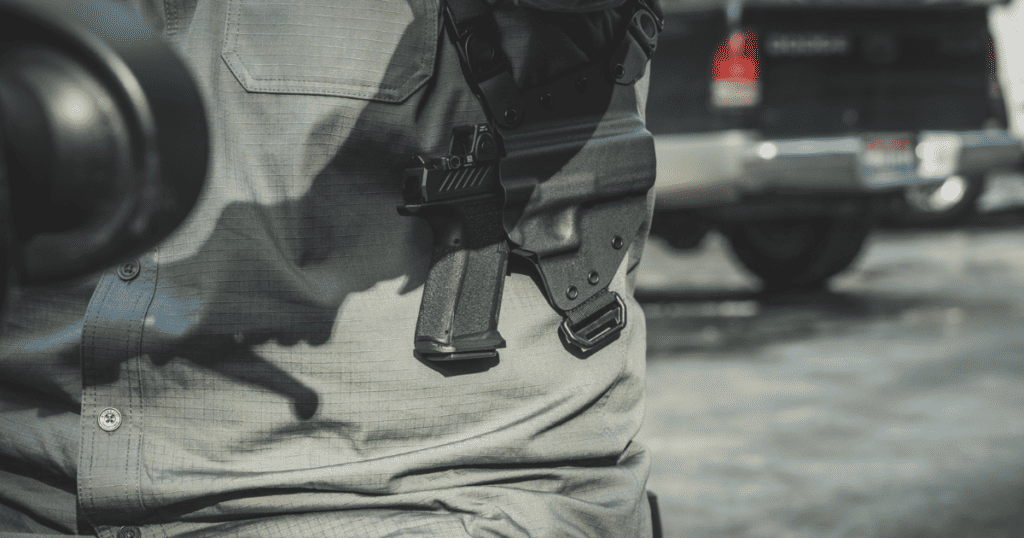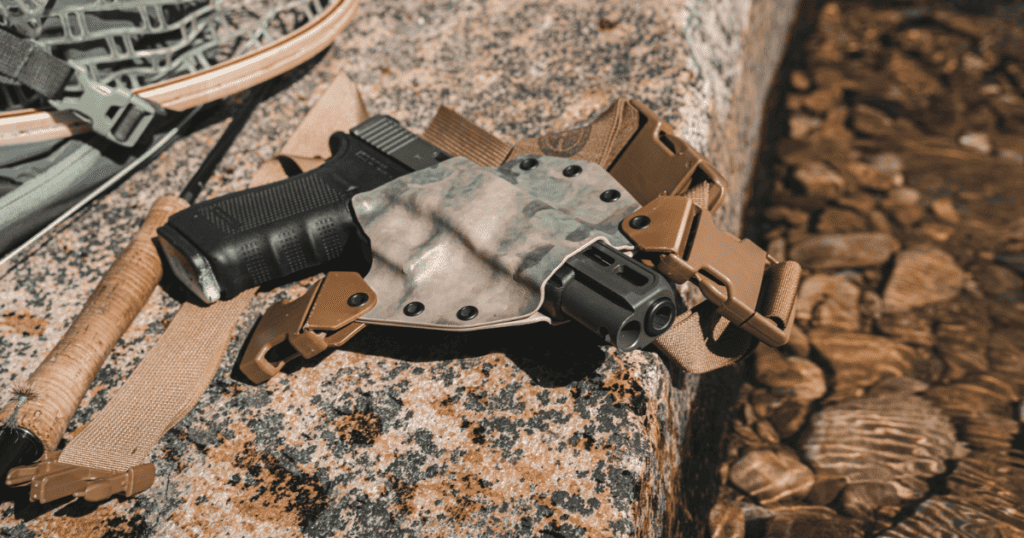At GunfightersINC, we believe in helping you understand everything about your holster, and that includes how holster retention helps hold onto your gun. Whether you’re moving around a lot, running, or jumping, you need the right retention to feel confident your gun will stay put until you’re ready to use it.
Let’s explore what holster retention is, the different types and levels, and how to choose the right retention holster for you.
Different Types of Holster Retention

What is holster retention?
Holster retention is all about how your holster holds onto your gun.
Good holster retention means your gun stays in the holster until you decide to draw it. This is super important because you don’t want your gun slipping out accidentally or someone else grabbing it.
Just as you want your seatbelt to keep you secure in a car, you want your holster to keep your gun safely in place.
When you have the right retention, you can move around, run, or even jump without worrying about your gun.
What are the different types of holster retention?
There are two main types of retention:
- Passive holster retention
- Active holster retention
What is the difference between passive and active holster retention?
Passive retention is based on the design and friction of the holster.
- It’s designed to hold the gun securely without any additional mechanisms or locks.
- Passive retention relies on the shape & material to create friction to keep the gun in place.
For example, all GunfightersINC holsters use passive retention-based friction to hold your gun in place. We design our holsters with exact fitment that won’t let your firearm come out unless drawn with intent.
Active retention involves mechanisms that lock the gun in the holster.
- This requires manual unlocking of a mechanism before the gun can be drawn.
- It provides an extra level of security & keeps the gun in place during vigorous activities.
What are the different retention devices on retention holsters?
There are 2 categories of retention devices: the ones that keep the gun in the holster and the ones that keep the holster attached to you.
Devices that keep the gun in the holster:
For example, these devices can be a thumb break (a strap over the gun that you snap off with your thumb) or a trigger guard lock (a lock around the part where the trigger is). They make sure your gun doesn’t fall out or get taken away easily.
These devices are found only on active retention holsters.
Devices that keep the holster attached to you:
They include hardware like a paddle, loops, FOMI clips, or even special quick-attach systems.
For example, we use MALICE loops on our Sentiel OWB Duty Holster so you can mount it to your PALS or MOLLE gear.
We also use FOMI clips on our IWB Wraith Holster and IWB Solace Holsters to create a thin profile for everyday carry. As an extra layer of security, we add a strip of Marine-grade tape to decrease holster slippage or movement
This all keeps the holster firmly attached to your belt or clothing, so it won’t move around or get lost.
Holster Retention Levels

What are the different holster retention levels?
Retention levels are numbered from 1 to 4. The levels tell you how secure your firearm is in the holster.
What is the difference between a Level 1 and Level 2 retention holster? Or the difference between a Level 2 and Level 3 retention holster?
Each level offers a different degree of security and is based on the number of actions required to release the weapon.
For example, a Level 1 holster requires one action to draw the firearm, while a Level 4 holster requires multiple actions for added security.
The higher the level, the more secure the firearm will be, however, your draw time will increase with each level of retention and it’s important to decide what balance of speed and security is correct for your unique situation. Here is a breakdown of each retention level:
Level 1 retention
A holster with Level 1 usually requires just one action to draw the gun and is used for passive retention holsters. This level is often enough for everyday carry where you don’t expect a lot of rough movement or risk of someone trying to grab your gun.
Level 2 retention
Level 2 requires you to do two actions to draw your gun and is used for active retention holsters. It’s a bit more secure and takes a little more effort to get your firearm out. This is the level you start to see retention mechanisms or devices.
Level 3 retention
At Level 3, you need to perform three actions to draw your gun from your active retention holster. This level offers higher security, especially when there’s a risk of someone else trying to take the gun.
Level 4 retention
The highest standard, Level 4 requires the most steps to draw your gun, offering the highest security. This level is typically used in high-risk situations.
What retention level do police use?
Police use a Level 3 active retention holster since they can find themselves in risky situations where someone might try to grab their gun. These holsters do have more steps to draw the gun, but it makes it harder for someone else to take it.
Do I need an active retention holster or passive retention? And what retention level do I need?

It’s important to understand and consider the type and level of retention when choosing a holster.
Higher levels of retention can provide more security by reducing the risk of accidental or unauthorized access to your gun.
However, it’s also important to balance security with accessibility, ensuring that you can draw the firearm quickly and efficiently when needed.
So when choosing a holster, how you plan to carry your gun makes a big difference.
Let’s break down what you need to know for each carry method:
Concealed Carry
If you’re carrying your gun concealed, like with an IWB (inside the waistband) holster, the chance of someone trying to take your gun is lower.
In this case, a holster with Level 1 passive retention is good since it keeps your gun secure without needing complex locks or mechanisms.
Open Carry
Open carry will use an OWB (outside the waistband) holster. For open carry, some may want a holster with more secure retention (like a Level 2 retention holster).
But at GunfightersINC, we believe a Level 1 passive retention holster works very well for open carry. Our OWB and IWB holsters are all designed with the proper fitment for your specific gun that creates the needed friction to hold it in place.
We don’t believe in having extra hardware that gets in the way of you accessing your gun in EDC (everyday carry).
Off-Body Carry
Off-body carry is when you carry your gun in something like a purse or your car. This method needs special attention because the gun isn’t attached to your body.
You have to make sure both the gun stays secure in the holster and the holster stays attached inside your bag. A holster with active Level 2 retention or higher would work best for this situation.
Competition
In the world of competitive shooting, things can get pretty active. Shooters move a lot, run, and jump.
Most of the time, passive retention is what shooters go for because they don’t have to worry about someone stealing their gun. But, because of all the movement, some competitors choose holsters with a bit more retention to make sure their gun stays put during all that movement.
What retention level holsters does GunfightersINC have?

We design and craft Level 1 passive retention holsters exclusively.
Each one of our holsters is crafted to match specific pistols to create the best Level 1 passive retention holster possible. We achieve this by hand testing every holster’s retention, in-house, with the actual firearm before it goes out the door. GunfightersINC does not use common “blue guns” at any step in our process to ensure our Level 1 retention is the best in the industry. We design our holsters for a range of weapons, from the Glock 17 to 48, Ruger, SIG Sauer, and more.
We believe a tailor-made holster designed specifically for your gun with quality Kydex material is all you need for an IWB and OWB carry holster.
This means our holsters will hold your gun securely, ensuring it won’t come out unless you mean to draw it.
We offer a variety of Level 1 passive retention holsters to suit your carrying needs:
Kenai Chest Holster
The Kenai Chest Holster is perfect for outdoor adventures.
It’s designed to carry big revolvers comfortably. This one is a favorite for those heading into the wilderness or for special military and law enforcement units.
Ronin OWB Concealment Holster
Our Ronin OWB Holster is the ultimate in comfort and concealment.
It’s built to handle dynamic movements like running or jumping. It’ll keep your firearm securely in place without complex locking mechanisms.
Solace Hybrid IWB Holster
For those who prioritize comfort, the Solace IWB Holster is your best bet.
Its design provides a comfortable carry without compromising security, ensuring your pistol stays put.
Sentinel OWB Duty Holster
The Sentinel OWB Holster is all about simplicity and durability.
It’s an excellent choice for duty carry, offering great comfort and versatility. It includes options to add a tactical light or a thigh platform.
Wraith IWB Holster
The Wraith IWB Holster is designed for low-profile and lightweight carry.
It’s versatile enough for different carry positions and fits seamlessly into your daily routine – whether you’re running to the store or need a backup on your plate carrier.
Spectre Shoulder Holster
Our Spectre Shoulder Holster revisits classic designs with modern construction.
It’s an innovative approach to concealed carry that blends timeless style with contemporary functionality.
Finding the Right Holster Retention for You
Whether you’re engaged in EDC or specialized situations, the right retention holster and level depend on your specific needs and circumstances.
Remember, the journey to responsible firearm ownership involves understanding every aspect of your gear, and holster retention is a crucial part of that.
Stay safe, prepared, and confident with the right holster retention for you.
December 20, 2023
